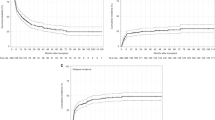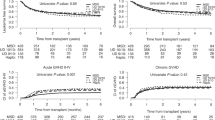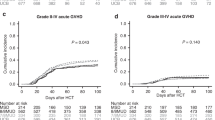Abstract
Allogeneic hematopoietic SCT (allo-HCT) from matched sibling donor (MSD) is recommended for younger patients with intermediate cytogenetic risk AML in first CR (CR1), whereas the role of alternative donor transplants in these patients is unknown. We retrospectively analyzed 605 patients with intermediate-risk AML, who received myeloablative allo-HCT in CR1. The 4-year OS for MSD (n=290) and matched unrelated donor (MUD; n=141) was 65% and 68% (P=0.50), respectively. In multivariate analysis, MUD had a similar risk of overall mortality as MSD (hazard ratio=0.90; 95% confidence interval, 0.62–1.30; P=0.58), whereas older age, female donor/male recipient (FDMR) combination, and requiring more than one course of induction chemotherapy to achieve CR1 were poor prognostic factors for OS. Thus, OS after MUD HCT with sex combinations other than FDMR was significantly higher than that after MSD HCT from female donors to male recipients (4-year OS 72% versus 55%, P=0.04). These results suggest that HCT, not only from MSD, but also from MUD, should be considered in younger patients with intermediate-risk AML in CR1, and that the donor–recipient sex combination is more important than the donor type in donor selection.
This is a preview of subscription content, access via your institution
Access options
Subscribe to this journal
Receive 12 print issues and online access
$259.00 per year
only $21.58 per issue
Buy this article
- Purchase on Springer Link
- Instant access to full article PDF
Prices may be subject to local taxes which are calculated during checkout


Similar content being viewed by others
References
Grimwade D, Walker H, Oliver F, Wheatley K, Harrison C, Harrison G et al. The importance of diagnostic cytogenetics on outcome in AML: analysis of 1,612 patients entered into the MRC AML 10 trial. The Medical Research Council Adult and Children's Leukaemia Working Parties. Blood 1998; 92: 2322–2333.
Slovak ML, Kopecky KJ, Cassileth PA, Harrington DH, Theil KS, Mohamed A et al. Karyotypic analysis predicts outcome of preremission and postremission therapy in adult acute myeloid leukemia: a Southwest Oncology Group/Eastern Cooperative Oncology Group Study. Blood 2000; 96: 4075–4083.
Ringden O, Pavletic SZ, Anasetti C, Barrett AJ, Wang T, Wang D et al. The graft-versus-leukemia effect using matched unrelated donors is not superior to HLA-identical siblings for hematopoietic stem cell transplantation. Blood 2009; 113: 3110–3118.
Rowe JM . Optimal induction and post-remission therapy for AML in first remission. Hematol Am Soc Hematol Educ Program 2009, 396–405.
Koreth J, Schlenk R, Kopecky KJ, Honda S, Sierra J, Djulbegovic BJ et al. Allogeneic stem cell transplantation for acute myeloid leukemia in first complete remission: systematic review and meta-analysis of prospective clinical trials. JAMA 2009; 301: 2349–2361.
Cornelissen JJ, van Putten WL, Verdonck LF, Theobald M, Jacky E, Daenen SM et al. Results of a HOVON/SAKK donor versus no-donor analysis of myeloablative HLA-identical sibling stem cell transplantation in first remission acute myeloid leukemia in young and middle-aged adults: benefits for whom? Blood 2007; 109: 3658–3666.
Suciu S, Mandelli F, de Witte T, Zittoun R, Gallo E, Labar B et al. Allogeneic compared with autologous stem cell transplantation in the treatment of patients younger than 46 years with acute myeloid leukemia (AML) in first complete remission (CR1): an intention-to-treat analysis of the EORTC/GIMEMAAML-10 trial. Blood 2003; 102: 1232–1240.
Dohner H, Estey EH, Amadori S, Appelbaum FR, Buchner T, Burnett AK et al. Diagnosis and management of acute myeloid leukemia in adults: recommendations from an international expert panel, on behalf of the European Leukemia Net. Blood 2010; 115: 453–474.
Schlenk RF, Dohner K, Mack S, Stoppel M, Kiraly F, Gotze K et al. Prospective evaluation of allogeneic hematopoietic stem-cell transplantation from matched related and matched unrelated donors in younger adults with high-risk acute myeloid leukemia: German-Austrian trial AMLHD98A. J Clin Oncol 2010; 28: 4642–4648.
Gupta V, Tallman MS, He W, Logan BR, Copelan E, Gale RP et al. Comparable survival after HLA-well-matched unrelated or matched sibling donor transplantation for acute myeloid leukemia in first remission with unfavorable cytogenetics at diagnosis. Blood 2010; 116: 1839–1848.
Walter RB, Pagel JM, Gooley TA, Petersdorf EW, Sorror ML, Woolfrey AE et al. Comparison of matched unrelated and matched related donor myeloablative hematopoietic cell transplantation for adults with acute myeloid leukemia in first remission. Leukemia 2010; 24: 1276–1282.
Schetelig J, Bornhauser M, Schmid C, Hertenstein B, Schwerdtfeger R, Martin H et al. Matched unrelated or matched sibling donors result in comparable survival after allogeneic stem-cell transplantation in elderly patients with acute myeloid leukemia: a report from the cooperative German Transplant Study Group. J Clin Oncol 2008; 26: 5183–5191.
Moore J, Nivison-Smith I, Goh K, Ma D, Bradstock K, Szer J et al. Equivalent survival for sibling and unrelated donor allogeneic stem cell transplantation for acute myelogenous leukemia. Biol Blood Marrow Transplant 2007; 13: 601–607.
Atsuta Y, Suzuki R, Yoshimi A, Gondo H, Tanaka J, Hiraoka A et al. Unification of hematopoietic stem cell transplantation registries in Japan and establishment of the TRUMP System. Int J Hematol 2007; 86: 269–274.
Przepiorka D, Weisdorf D, Martin P, Klingemann HG, Beatty P, Hows J et al. Consensus Conference on Acute GVHD Grading. Bone Marrow Transplant 1995; 15: 825–828.
Sullivan KM, Shulman HM, Storb R, Weiden PL, Witherspoon RP, McDonald GB et al. Chronic graft-versus-host disease in 52 patients: adverse natural course and successful treatment with combination immunosuppression. Blood 1981; 57: 267–276.
Gooley TA, Leisenring W, Crowley J, Storer BE . Estimation of failure probabilities in the presence of competing risks: new representations of old estimators. Stat Med 1999; 18: 695–706.
Scrucca L, Santucci A, Aversa F . Competing risk analysis using R: an easy guide for clinicians. Bone Marrow Transplant 2007; 40: 381–387.
Lee SJ, Klein J, Haagenson M, Baxter-Lowe LA, Confer DL, Eapen M et al. High-resolution donor-recipient HLA matching contributes to the success of unrelated donor marrow transplantation. Blood 2007; 110: 4576–4583.
Randolph SS, Gooley TA, Warren EH, Appelbaum FR, Riddell SR . Female donors contribute to a selective graft-versus-leukemia effect in male recipients of HLA-matched, related hematopoietic stem cell transplants. Blood 2004; 103: 347–352.
Stern M, Brand R, de Witte T, Sureda A, Rocha V, Passweg J et al. Female-versus-male alloreactivity as a model for minor histocompatibility antigens in hematopoietic stem cell transplantation. Am J Transplant 2008; 8: 2149–2157.
Nannya Y, Kataoka K, Hangaishi A, Imai Y, Takahashi T, Kurokawa M . The negative impact of female donor/male recipient combination in allogeneic hematopoietic stem cell transplantation depends on disease risk. Transpl Int 2011; 24: 469–476.
Oh H, Loberiza FR, Zhang MJ, Ringden O, Akiyama H, Asai T et al. Comparison of graft-versus-host-disease and survival after HLA-identical sibling bone marrow transplantation in ethnic populations. Blood 2005; 105: 1408–1416.
Kurosawa S, Yamaguchi T, Uchida N, Miyawaki S, Usuki K, Watanabe M et al. Comparison of allogeneic hematopoietic cell transplantation and chemotherapy in elderly patients with non-M3 acute myelogenous leukemia in first complete remission. Biol Blood Marrow Transplant 2011; 17: 401–411.
Burnett AK, Wheatley K, Goldstone AH, Stevens RF, Hann IM, Rees JH et al. The value of allogeneic bone marrow transplant in patients with acute myeloid leukaemia at differing risk of relapse: results of the UK MRC AML 10 trial. Br J Haematol 2002; 118: 385–400.
de Lima M, Couriel D, Thall PF, Wang X, Madden T, Jones R et al. Once-daily intravenous busulfan and fludarabine: clinical and pharmacokinetic results of a myeloablative, reduced-toxicity conditioning regimen for allogeneic stem cell transplantation in AML and MDS. Blood 2004; 104: 857–864.
Russell JA, Duan Q, Chaudhry MA, Savoie ML, Balogh A, Turner AR et al. Transplantation from matched siblings using once-daily intravenous busulfan/fludarabine with thymoglobulin: a myeloablative regimen with low nonrelapse mortality in all but older patients with high-risk disease. Biol Blood Marrow Transplant 2008; 14: 888–895.
Bonetti F, Zecca M, Pession A, Messina C, Montagna D, Lanino E et al. Total-body irradiation and melphalan is a safe and effective conditioning regimen for autologous bone marrow transplantation in children with acute myeloid leukemia in first remission. The Italian Association for Pediatric Hematology and Oncology-Bone Marrow Transplantation Group. J Clin Oncol 1999; 17: 3729–3735.
Schlenk RF, Dohner K, Krauter J, Frohling S, Corbacioglu A, Bullinger L et al. Mutations and treatment outcome in cytogenetically normal acute myeloid leukemia. N Engl J Med 2008; 358: 1909–1918.
Acknowledgements
This study was supported by the Ministry of Health, Labor and Welfare of Japan Grant-in-Aid (KM). We thank all of the staff of the participating institutions of the Japan Society for Hematopoietic Cell Transplantation and the Japan Donor Marrow Program. We thank Dr Y Kuwatsuka for thoughtful discussion.
Author information
Authors and Affiliations
Corresponding author
Ethics declarations
Competing interests
The authors declare no conflict of interest.
Rights and permissions
About this article
Cite this article
Imahashi, N., Suzuki, R., Fukuda, T. et al. Allogeneic hematopoietic stem cell transplantation for intermediate cytogenetic risk AML in first CR. Bone Marrow Transplant 48, 56–62 (2013). https://doi.org/10.1038/bmt.2012.84
Received:
Revised:
Accepted:
Published:
Issue Date:
DOI: https://doi.org/10.1038/bmt.2012.84
Keywords
This article is cited by
-
Hematopoietic stem cell transplantation for acute myeloid leukemia
International Journal of Hematology (2018)
-
Allogeneic Stem Cell Transplantation for Acute Myeloid Leukemia in First Complete Remission: Are We Closer to Knowing Who Needs It?
Current Hematologic Malignancy Reports (2014)
-
Hematopoietic Stem Cell Transplantation for Acute Myeloid Leukemia: To Whom, When, and How
Current Oncology Reports (2013)



